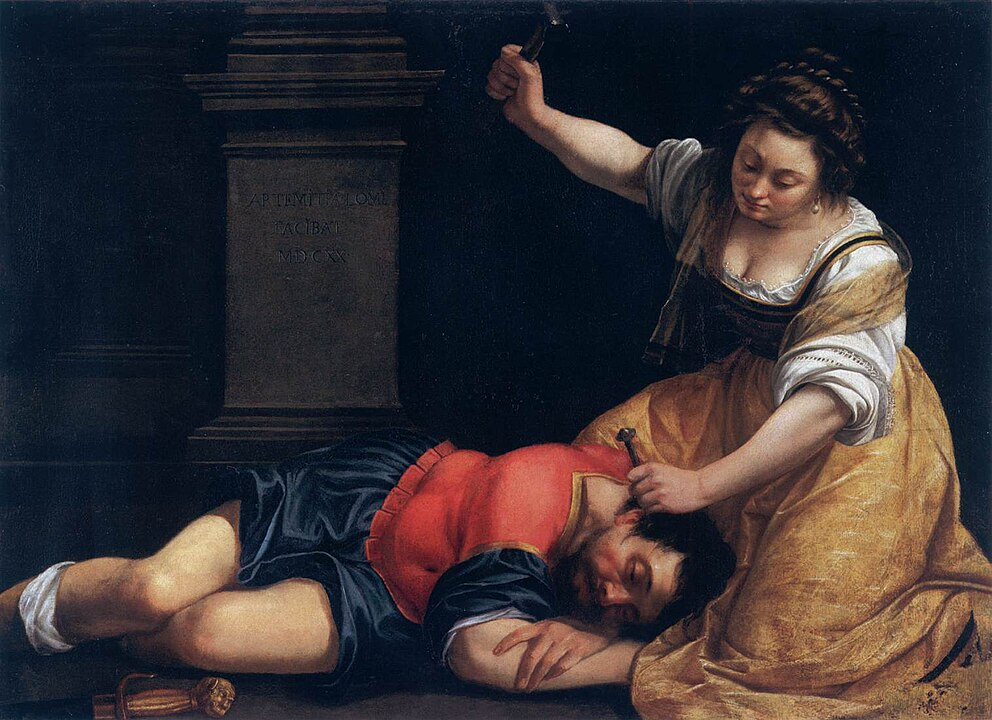Artemisia Gentileschi’s Jael and Sisera(1620)
Introduction
Artemisia Gentileschi’s Jael and Sisera invites us into a moment of raw, unsettling power—a woman’s courage intersecting with divine justice. The painting freezes the dramatic scene where Jael drives a tent peg through Sisera’s temple, ending the reign of the Canaanite general who oppressed Israel for twenty years.
At first, the image is brutal and tense. But as you pause, you realize it’s a meditation on how God chooses the unexpected—ordinary tools, overlooked people—to carry out His deliverance. Gentileschi, herself a woman who overcame trauma and injustice, brings a fierce honesty to this story of strength born from vulnerability and resistance.
The Artist and Her Story
Artemisia Gentileschi painted this work when she was just 27, after surviving a brutal assault and a public trial that tried to silence her. She became a trailblazer in 17th-century Italy, one of the few female artists of her time—and a rare woman to paint such intense biblical scenes of female strength.
Artemisia Gentileschi’s Self-Portrait as the Allegory of Painting is more than a painting—it’s a declaration. She shows herself fully immersed in the creative act, challenging the barriers women faced in the 1600s. In this powerful image, Artemisia claims her place not just as a subject, but as the very embodiment of artistic skill and passion. It’s a bold reminder that talent and calling aren’t limited by gender.
Her choice of subjects like Jael reflects her own experience of resilience. Like Jael, Artemisia stood against a world dominated by men and used her voice and art to reveal stories of women who defied victimhood.
A Closer Look at the Painting
The scene’s dramatic lighting pulls us into Jael’s world, spotlighting her hands gripping the hammer and tent peg. The tension in her face is palpable—this is a moment of decisive, difficult action, not quiet piety.
Sisera lies beneath her, defeated and vulnerable, the once-mighty warrior brought low by a woman’s unexpected courage. Jael’s rich clothing contrasts with her violent act, reminding us that God uses everyday people and everyday objects to overturn power.
Gentileschi’s use of chiaroscuro—the sharp contrast of light and shadow—creates intimacy. We are no longer distant observers but witnesses to a moment where divine justice meets human bravery.
The title Peace of Sisera and Jael captures the tension between violence and unexpected resolution in their story. Though Sisera’s end is brutal, the moment also reveals a strange kind of peace—one born from justice and divine intervention. It reminds us that peace sometimes comes through courage, sacrifice, and the unsettling work of God’s deliverance.
Theological Reflection
Jael’s story (Judges 4–5) challenges us to wrestle with uncomfortable truths. She violates ancient codes of hospitality to fulfill a higher justice. Sisera is no innocent; he was the agent of oppression and terror. Jael’s choice highlights the tension between political alliances and spiritual faithfulness, between fear and courage.
Her tent peg symbolizes God’s way of using the weak to shame the strong (1 Corinthians 1:27). Sisera’s iron chariots—the height of military technology—are defeated not by might but by a humble household tool wielded by a determined woman.
What Jael’s Story Means for Us
Gentileschi’s Jael and Sisera calls us to consider our own moments of calling. We may not face battles like Jael, but we all encounter decisions between safety and courage, comfort and conviction.
Her story reminds us that God equips ordinary people with whatever they have—tools, strength, faith—to carry out His work. It challenges us to examine our loyalties, to choose God’s justice even when it’s costly or countercultural.
Finally, Jael shows us the courage it takes not only to act but to own those actions openly. When Barak pursued Sisera, she met him boldly and declared what she had done. There’s power in standing firm in the truth, even when it surprises or unsettles others.
For anyone who has felt overlooked or powerless, Jael’s story offers hope: God’s deliverance often comes through those who know what it means to be vulnerable and brave.
Related Posts
Deborah in the Bible: Judge, Prophetess, and Leader
Discover the prophetess who called Jael’s moment into being and the dynamic leadership that shaped Israel’s deliverance.
Barak in the Bible: Warrior, Partner, and Man of Faith
Learn about the warrior whose pursuit forced Sisera into Jael’s tent, setting the stage for her decisive act.
Jael in the Bible: Unexpected Hero, Unexpected Woman
Explore Jael’s biblical story in greater depth—the woman behind the legend.
Artemisia Gentileschi’s Jael and Sisera hangs in Budapest’s Museum of Fine Arts, continuing to challenge and inspire viewers centuries later. It asks us to consider: How might God use our own ordinary tools and unexpected moments for extraordinary purposes?

